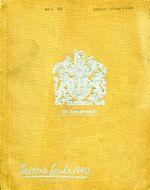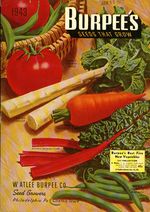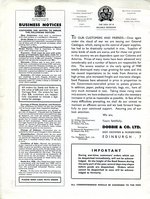Wartime conditions on both sides of the Atlantic encouraged gardeners to devote as much space as possible to growing food crops, and catalogues advertised varieties that were high in vitamins. The American Victory Garden and British Dig for Victory campaigns were featured prominently at the beginning of catalogues along with collections of vegetables. Catalogues also urged gardeners to plant flowers for comfort, and to make vegetable gardens more attractive. Jackson & Perkins’ catalogue of 1944 quoted H.W. Hochbaum, Chairman of the Victory Garden Committee of the USDA: “We owe it to Johnny and Joan as they come marching home that the old home and the old home town welcome them with more flowers and greenery”. The scans from Burpee’s, Carter’s Tested Seeds, and Sutton’s Seeds show how seed companies encouraged victory gardening.
As the war raged on, catalogues warned customers of scarce supplies and delays in service. The back cover of Dobbie’s 1941 catalogue encouraged war emergency planting of fruit trees and warned that gooseberries were becoming scarce. In the Autumn 1944 Sutton’s seed catalogue, the proprietors apologized that “owing to the scarcity of stocks due to war conditions, we regret to be unable to offer fruit trees this season” Ryder’s order form of 1944 said that although they would have removed all slightly blemished potatoes from customer orders before the war, this practice was no longer in the national interest, since it was of primary importance to prevent waste. It also offered customers the opportunity to order a booklet on wartime gardening by Raymond A. Cook, entitled "Plots against Hitler."





